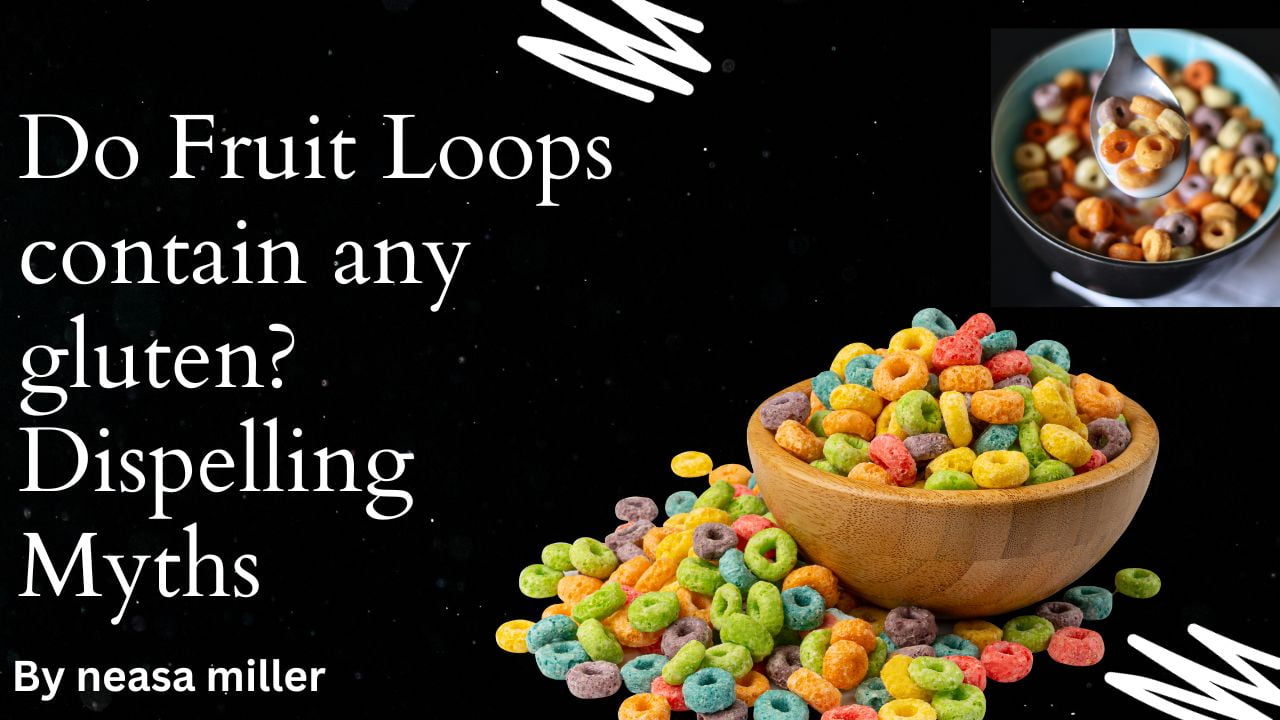In this illuminating investigation, we delve inside the vibrant world of Fruit Loops to dispel misconceptions and learn the real gluten story. It’s important to distinguish fact from fiction when it comes to our favourite breakfast foods because gluten has become a buzzword in the nutrition industry.
Understanding what we eat is more crucial than ever in today’s health-conscious society. Nothing special than a healthy cereal breakfast. In this article, we explore some major questions Frequently asked Do FruitLoops contain any gluten? Let’s examine the facts and dispel any myths about this topic.
What Are Fruit Loops?
As you already know if you don’t then now you are familiar with Fruit Loop. FruitLoops are a very well-known breakfast cereal. This iconic cereal is made by Kellogg’s and is available worldwide. It has a pleasant, fruity flavour and comes in ring shapes. They have many flavours and are strong and vibrant.
Are Fruit Loops Gluten-free or not?
No, unfortunately, Fruit Loop is not gluten-free because it is made of wheat flour. If you know that wheat, rye, and barley contain gluten they are the main component of fruit loops. If you have celiac disease please do not eat fruit loops. On the other hand, The maker of FruitLoops, Kellogg’s, understands the value of fulfilling a variety of dietary requirements. As a result, now they offer a gluten-free version of Fruit Loops.
Ingredients of Fruit loops
We’ve already discussed with you that wheat flour is used in Fruit Loops. However, you might be interested to discover what additional elements the cereal contains. Right? Well, I’ve also covered it. The full list of ingredients for Kellogg’s Fruit Loops is provided below.
- Wheat flour
- Blend of corn flour
- Sugar
- Modified starch
- Whole grain oat flour
Less than 2% of
| Ingredients |
| Oat fibre |
| Vegetable oil, including cottonseed, soybean, and/or hydrogenated coconut oil |
| Maltodextrin |
| Salt |
| Natural flavour |
| Soluble corn fibre |
| Red 40 |
| Yellow 5 |
| Yellow 6 |
| Blue 1 |
| BHT for freshness |
| Vitamin C (ascorbic acid) |
| Niacinamide |
| Reduced iron |
| Vitamin B2 (riboflavin) |
| Folic Acid |
| Vitamin B6 (pyridoxine hydrochloride) |
| Vitamin B1 (thiamin hydrochloride) |
| Vitamin D3 |
| Vitamin B12 |
Are Fruit Loops both vegan and healthy?
Due to the inclusion of some ingredients that come from animals, FruitLoops is not regarded as a wholly vegan cereal. In comparison to whole foods, they might not be the healthiest choice, but they can be consumed in moderation as part of a balanced diet.
Vegan Consideration: FruitLoops contain various substances that are not suitable for vegans, such as vitamin D3, which is frequently sourced from lanolin, a material made from sheep’s wool. Furthermore, some vegans might be concerned by the cereal’s use of specific colourings. If you adhere to a vegan diet, it is advised that you carefully review the ingredient list and select cereals that expressly indicate they are vegan or do not contain products derived from animals.
Health consideration: FruitLoops are a type of sugary cereal, and while they might be good as a treat once in a while, they are not often thought of as a healthy option. They have relatively little dietary fibre and important nutrients while being heavy in added sugars. Consider eating whole-grain cereals, muesli, or fresh fruits for breakfast if you’re seeking a healthier option.
Always keep in mind that diversity and balance are essential for a healthy diet. If you prefer FruitLoops, it’s ideal to consume them in moderation as a part of a diet that also includes nutrient-dense foods like fruits, vegetables, whole grains, and lean proteins. Consulting with a qualified dietitian or nutritionist might offer you individualised advice if you have certain dietary objectives or limits.
Gluten-Free Alternative to Fruit Loops:
There are a number of products on the market that offer a similar vibrant and tasty cereal experience as gluten-free alternatives to FruitLoops. For those who have celiac disease or gluten sensitivity, these substitutes are made without gluten-containing substances. Here are a few options for cereal that are free of gluten that you might like:
1. Barbara’s Honey Rice Puffins: These honey-sweetened puffed rice cereal bits, which are gluten-free, are a tasty and light breakfast option.
2. Erewhon Organic Fruity Rice Twice.
3. Brown rice crisps with sprouts from One Degree Organic Foods
4. Freedom Foods Tropicos: A cereal with a blend of natural flavours and a tropical theme created from corn and sorghum.
A gluten-free option is also available from Kellogg’s in the shape of FruitLoops, which are specially made to be gluten-free. They are manufactured using substitute components that do not contain gluten. There are some gluten-free brands which are given below:
- Blue Diamond Almond Nut Thins.
- Good Thins.
- Mary’s Gone Crackers.
- Milton’s Gluten-Free Crackers.
- Nairn’s Cookies and Crackers.
- Simple Mills Crackers.
- Lucky Charms, Cheerios, Love Grown Foods, Arrowhead Mills, Nature’s Path, and Forager Project.
To confirm that the cereal is gluten-free, always check the product label because manufacturing procedures can change. Additionally, keep in mind that even though certain cereals are gluten-free, their nutritional value can still differ, so it’s a good idea to examine labels if you’re searching for particular nutritional advantages.
How to make fruit loops at home
1. Ingredients Required: Assemble the necessary components before making your gluten-free Fruit Loops, a mixture of gluten-free flour, Sugar, baking soda, Sodium Eggs, Milk Vanilla extract, Food colouring in a variety of hues, and bagging pipes.
2. Preparing the Dough: Start by mixing the gluten-free flour blend, sugar, baking powder, and a pinch of salt in a bowl. In another bowl, whisk together eggs, vanilla extract, and milk. Gradually add the wet ingredients to the dry ones, creating a smooth dough. Divide the dough into smaller portions for colouring.
3. Creating the Fruit Loop Shapes: Add vibrant food colouring to each dough portion and knead until the colours are well incorporated. Roll out the coloured dough and use a Fruit Loop template or a small circular cookie cutter to create the ring shapes. Place the shapes on a baking sheet covered with parchment paper.
4. Fruit loops drying process: To get the distinctive crunchiness let the fruit loop for a few hours to air dry.
5. Toasting and Serving: Dry the Fruit Loops and then toast them in a hot oven until they are crisp and brown. serving them with milk or yoghurt of your choice.
6. Tips for storing: Store your Fruit Loops in an airtight container to keep their crunch. They make a wonderful alternative for breakfast or a snack and can be enjoyed for several weeks.
Summary
Certainly! Here’s a straightforward list of key points to understand about whether Fruit Loops contain gluten and dispelling myths:
- Fruit Loops are Not Gluten-Free: Fruit Loops are not gluten-free; they contain ingredients like wheat flour, which contains gluten.
- Common Misconception: There’s a common misconception that Fruit Loops are gluten-free because they are fruity and colorful, but the primary ingredient, wheat, contains gluten.
- Gluten-Free Alternatives: If you’re on a gluten-free diet, look for cereals specifically labeled as “gluten-free” at the store to avoid gluten-related issues.
- Read Labels: Always check the product labels for allergen information, including gluten, to ensure you make the right dietary choices.
- Cross-Contamination Warning: Even if a cereal doesn’t contain gluten ingredients, cross-contamination can occur during production, so it’s essential to be cautious if you have severe gluten sensitivity or celiac disease.
- Consult a Professional: If you have dietary concerns or health issues related to gluten, consult with a healthcare professional or dietitian for personalized guidance.
Remember, while Fruit Loops might be delicious, they are not suitable for those on a gluten-free diet due to their wheat-based ingredients.
Final Observations
In conclusion, addressing the question “Do FruitLoops contain any gluten?” Clearly shows that there are healthier alternatives to Fruit Loops even though they include gluten. Actually, there are many additional gluten-free brand options. You’ll find it surprisingly simple to locate gluten-free cereal as long as you read the ingredient labels before buying and choose items with a “gluten-free” label when it’s possible.
Creating your own gluten-free Fruit Loops at home is a rewarding and enjoyable culinary adventure. With just a few simple ingredients and some creativity, you can relish the taste of this classic cereal while adhering to your dietary needs.
Related Posts

I’m Neasa Miller, a professional dietitian with 5 years of experience. I founded glutenfreelifestyles.org to assist people online in embracing gluten-free living. Read more about me
